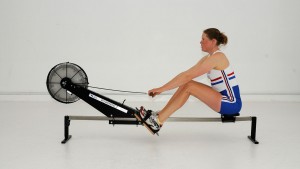Rowing Machine Technique
Good technique on the indoor rower will maximise the benefit of your training and ensure that you do not injure yourself
There can be a wide variety of differing techniques. Although not all of these can result in injury, you do need to have a degree of competence to minimise any risk.
Good technique produces maximum speed for minimum effort!
The model of British Rowing Technique has been developed by the GB High Performance Coaches on the Technical Panel of British Rowing.
You can look through the sequence of photos of Fran Houghton and accompanying explanation to help you perfect your indoor rowing technique.
Drive Phase
Recovery Phase
The rowing stroke is defined by a long drive phase and a relaxed and controlled recovery.
| Drive Phase | |
|---|---|
 | The drive phase is initiated with a push from the legs. |
 | As the legs reach half their extension, the hip angle begins to open. |
 | Once the legs are fully extended and the back is vertical the arms begin to draw the handle to the body. |
 | The handle finishes about half way up the body. The elbows follow the line of the handle and the wrists stay in line with the forearm. |
- Drive Phase

- The drive phase is initiated with a push from the legs.

- As the legs reach half their extension, the hip angle begins to open.

- Once the legs are fully extended and the back is vertical the arms begin to draw the handle to the body.

- The handle finishes about half way up the body. The elbows follow the line of the handle and the wrists stay in line with the forearm.
The recovery phase is as important as the drive. If this element is co-ordinated correctly it makes the drive phase instinctive. It is therefore this element that many rowers concentrate on during practice. The recovery is very similar to the drive phase but in reverse.
| Recovery Phase | |
|---|---|
 | The finish position with the legs and back straight. |
 | The recovery is initiated with the arms straightening. |
 | The body pivots from the hips, before the legs bend. |
 | The legs flex until the shins are vertical. |
- Recovery Phase

- The finish position with the legs and back straight.

- The recovery is initiated with the arms straightening.

- The body pivots from the hips, before the legs bend.

- The legs flex until the shins are vertical.
Throughout the co-ordination of the drive and recovery phases, the back should remain in a ‘neutral position’ (flat back, pivoting from the hips). This will help transmit the power generated from the legs to the handle and allow the force to be evenly spread throughout the spine, minimising the potential for any harm.
Check out our technique video with double Olympic champion Alex Gregory...
Want to learn more?
The most effective way to learn any skill is with a qualified coach. Rowing clubs may offer an opportunity to come and try a session. This is a chance for you to get some feedback from a coach as well as seeing if you like the sport. If you decide that you want to return to the gym then at least you go back with more than you initially knew. Some gyms have qualified instructors but check their credentials and gauge the instruction they give you on the basis of their level of competence.
You will not always have a coach or instructor available so one of the best ways to develop your technique is to watch what you are doing. Most gyms have a mirror where you can observe your technique while you are training. The key is to have a mental image of what you are trying to achieve and then attempt to copy it.
Alternatively, visit Inside Indoor, our dedicated indoor rowing site, which is packed with advice and videos on training and technique for indoor rowers.












